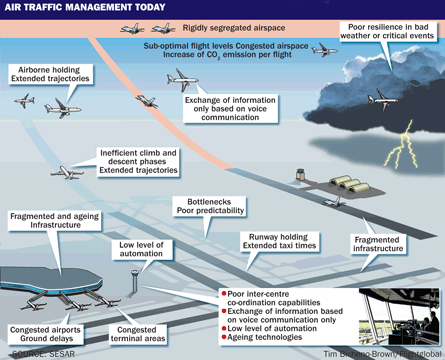The first measures heralding a new-age air traffic management system in a Single European Sky will be in place by the end of this year. That is the promise made to delegates this month at the ATC Global Conference in Amsterdam by Patrick Ky, head of the SES research organisation known as the SESAR Joint Undertaking.
These modest changes in procedure and system communications will go unnoticed by passengers. But, as two senior ATM leaders have warned, the long-term changes are not going to be modest, nor are they going to be few if the improvements necessary to support safe, low-emission, cost-efficient aviation in the future are to be brought about.
Eurocontrol director general David McMillan warned at ATM Global that "change, or the threat of it", has already caused a lot of industrial unrest among air traffic control officers, particularly in Spain and France. But, he hinted, this is nothing compared with what the future it likely to bring. Maurice Georges, chief executive of French ATM provider DSNA, says industrial action last year by air traffic control officers caused more disruption to air traffic in French airspace than Icelandic volcanic ash did.
 |
|---|
European ATM is inefficient. McMillan says its productivity is half that of the US system, which itself is preparing for renewal. The classic single example is the fact that, for a large part of every day, aeroplanes circle pointlessly in the sky above London, burning expensive, polluting fuel, waiting for a chance to land at Heathrow airport.
But there are countless other inefficiencies that must also be eliminated (see diagram). The system that would replace this will not let aeroplanes push back for departure unless the entire system is ready for an uninterrupted journey by every individual aeroplane.
Each aircraft will fly a four-dimensional "trajectory", with required times of arrival at each waypoint and the destination, and separated from every other trajectory by a network communications system that will have reached neurological levels of capability.
The trouble is that this high-tech world will not need all the current air traffic control centres, which at present number more than one per country. It needs between four and six for the whole of Europe, and it will only need that many because some redundancy is required.
Air traffic control officers are highly paid, highly skilled people, and ATM is a high-tech business even today, supporting other skilled jobs such as engineering and maintenance. Not only will the officers fight for their jobs and way of life, politicians will not want to see skilled jobs disappear from their constituencies.
Some politicians will also fight change or, more probably, avoid taking decisions, so change will be halted. Making this almost inevitable is the fact that, in all Europe's member states except the UK, ATM is owned by the state.
Richard Deakin, head of the UK's semi-privatised ATM provider NATS, says the future challenges for Europe are "technical, political and social". He says that the SESAR JU "is providing the bricks to build the new house, but no-one has spoken to the architect". Perhaps that is because an architect has not been hired, and who would this multinational person be?
Deakin believes the whole edifice, if it is to be built, cannot be constructed without "commonly agreed principles". At present, he reveals, the six largest and most influential air navigation service providers - those of France, Germany, Italy, Spain, Sweden and the UK and known as the A6 - are trying to agree those principles.
They know the technology and the operational objectives have been agreed, but the problem is how to turn the ideas into reality when the ideas are controlled by politicians in some 40 sovereign states.
Spain is about to privatise one part of its national ATM: it is liberalising its airport ATM provision and has called for bids. NATS is bidding, having joined Spanish transport giant Ferrovial in a company called FerroNATS.
ATM workers will wonder, justifiably, whether this is the thin end of a wedge. Privatisation could be, for the politicians, the least painful way of modernising. And it is low cost.
Meanwhile, SESAR JU-approved measures will creep in one by one, gradually improving performance between chosen city pairs and validating procedures for wider introduction. But it is not enough to bring a few new measures into an old system. The old system has to renew itself beyond recognition.
Source: Flight International
















